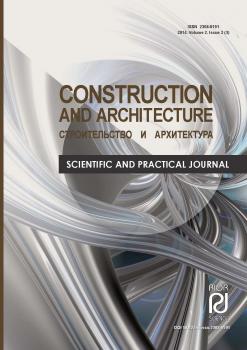from 01.01.2016 to 01.01.2019
tambovskiy gosudarstvennyy tehnicheskiy universitet
tambov, Tambov, Russian Federation
Tambov, Russian Federation
tambov, Russian Federation
tambov, Russian Federation
tambovskiy gosudarstvennyy tehnicheskiy universitet
tambov, Russian Federation
Tambov, Russian Federation
UDC 69
CSCSTI 38.19
CSCSTI 67.11
CSCSTI 67.01
Russian Classification of Professions by Education 08.04.01
Russian Library and Bibliographic Classification 385
Russian Library and Bibliographic Classification 308
BISAC BIB001070 Christian Standard Bible / Youth & Teen
The coupling of concrete with fiberglass reinforcement at different values of its diameter and depth of sealing is investigated. The difference in the distribution of tangent stresses over the depth of reinforcement bars‘ sealing is determined due to their diameters, which is reflected in the nature of the destruction of fiberglass reinforcement when it is pulled out of concrete. The values of correction coefficients that take into account the dependence of the fullness of the tangent stress plot in the sealing area on the diameter of the reinforcing bar are determined. Recommendations for calculating the base length of the fiberglass reinforcement anchorage in concrete are given.
breakout, concrete, coupling, steel rebar, composite rebar, anchor depth
1. Kholmyansky, M. M. contact of reinforcement with concrete. - Moscow: Stroizdat, 1981. - 184 p.
2. Oatul, A. A. Proposals for the construction of the theory of coupling of reinforcement with concrete / / Concrete and reinforced concrete. - 1968. - No. 12. - p. 8-10.
3. A.V. Benin [et al.]. Mathematical modeling of the process of breaking the coupling of reinforcement with concrete.Part 1. Models taking into account the connection discontinuity / / Engineering and construction journal. - 2013. - No. 5. - c. 86-144.
4. Benin, A.V. Deformation and destruction of reinforced concrete: analytical, numerical and experimental studies: Monogr.; PGUPS. - SPb., 2006. - 127 p.
5. Gizdatullin, A. R. Features of tests and character of destruction of polymer composite reinforcement /A. R. Gizdatullin, V. G. Khozin, A. N. Kuklin, A. M. Khusnutdinov / / Engineering and construction magazine. - 2014. - No. 3. - Pp. 40-47.
6. A. N. Nikolyukin, V. P. Yartsev, I. I. Kolomnikova [and others]. Experimental studies of the bonding strength of fiberglass reinforcement with cement-sanded concrete / / Transport structures. - 2019. - Vol. 6, no. 1. - DOI:https://doi.org/10.15862/02SATS119.
7. Duan ZH., Kou SC., Poon CS. (2013) Prediction of compressive strength of recycled aggregate concrete using artificial neural networks. Constr Build Mater 40:1200-1206.
8. GOST 31938-2012. Composite polymer reinforcement for reinforcing concrete structures. General specifications. NIIBE them. A. A. Gvozdeva. - Moscow, 2013. - 42 p.
9. V. G. Khozin, [et al.]. Coupling of polymer composite reinforcement with cement concrete/ / Izvestiya kgasu. - 2013. - No. 1 (23). - Pp. 214-220.
10. Dalinkevich, A. A. Modern basalt fibers and polymer composite materials based on them (review) / A. A. Dalinkevich, K. S. Gumargalieva, S. S. marakhovsky, A.V. Sukhanov // Constructions from composite materials. - 2010. - No. 3. - Pp. 37-54.
11. Gutnikov, S. I., Lazoryak, B. I., Seleznev, A. N. Glass fibers: a textbook. - Moscow: Moscow state University. M. V. Lomonosova, 2010. - 53 p.
12. Grassl P., Davies T., Lattice modelling of corrosion induced cracking and bond in reinforced concrete // Cement and Concrete Composites. - 2011. - Vol. 33. - No. 9. - P. 918-924.
13. Gizdatullin, A. R. Features of tests and character of destruction of polymer composite reinforcement /A. R. Gizdatullin, V. G. Khozin, A. N. Kuklin, A. M. Khusnutdinov / / Engineering and construction magazine. - 2014. - No. 3. - Pp. 40-47.
14. Puck.A. Festigkeitsanalyse von Faser-Matrix Laminaten. Carl Hanser. 1996. Amleh L., Ghosh A. (2006) Modeling the effect of corrosion on bond strength at the steel-concrete interface with finiteelement analysis. Can J Civ Eng 33:673-682.
15. Rimshin I. V. Kustikova Yu. O. Phenomenological studies of the coupling value of basalt-plastic reinforcement with concrete / / Izvestiya YUZGU. Technique and technology series. 2011. No. 1. Pp. 27-31.
16. Kudyakov, K. L. Strength and crack resistance of bent concrete elements with basalt-fiber and rod glass-composite reinforcement under static and short-term dynamic loading: Diss.Cand. Techn. sciences'. T: trace. 2018. P. 208.
17. Kokovtseva A.V., Semenov S. G. Modeling of the process of pulling fiberglass reinforcement from a concrete block / / proceeding of the conference with international participation "XIII week of science SPBSPU". 2013.Pp. 182-184.
18. Gutnikov S. I., Lazoryak B. I. Glass fibers: a textbook. Moscow: Moscow state University. M. V. Lomonosova, 2010. 53 p.
19. Yalcıner H., O. Eren, Serhan S. An experimental study on the bond strength between reinforcement bars and concrete as a function of concrete cover, strength and corrosion level. Cem Concr Stock.2012. Nol 14 .P. 643-655.
20. Nikolyukin A. N., Yartsev V. P. Numerical modeling of composite reinforcement for the problem of coupling with concrete / / Bulletin of the Belgorod state technological University. V. G. Shukhov . 2019. No. 5. Pp. 56-65.
21. Nikolyukin N. A., Yartsev V. P. Modeling the coupling of reinforcement in concrete based on an artificial neural network. Russian Journal of Building Construction and Architecture.2019. No. 3 (43).Pp. 6-16.
22. Giyasov B. V. Yartsev, A. Nikolyukin, Abdul Barei Danish, I. Giyasova, D. Aljaboobi The impact of high-rise buildings on the living environment. E3S Web of Conferences Ser. High-Rise Construction .2019. Pp. 10-16.
23. Mermerdas K., Guneyisi E., Gesoglu M., Ozturan T. Experimental evaluation and modeling of drying shrinkage behavior of metakaolin and calcined kaolin blended concretes. Constr Build Mater.Nol 43.2013.P. 337-347.
24. Duan ZH., Kou SC., Poon CS. Prediction of compressive strength of recycled aggregate concrete using artificial neural networks.Constr Build Mater .Nol 40.2013.P. 1200-1206.
25. Adhikary B. B., Mutsuyoshi H. Prediction of shear strength of steel fiber RC beams using neural networks. Constr Build Mater. Nol 20(9).2006. P. 801-811.
26. Nikolyukin A. N., Yartsev V. P., Mamontov S. A., Kolomnikova I. I., al ward A. M. Analysis of the stress-strain state of concrete and rebar in the area of their engagement in the ANSYS software complex. Vestnik BSTU im. V. G. Shukhov. 2019. No. 11. Pp. 43-52. DOI:10.34031 / 2071


















